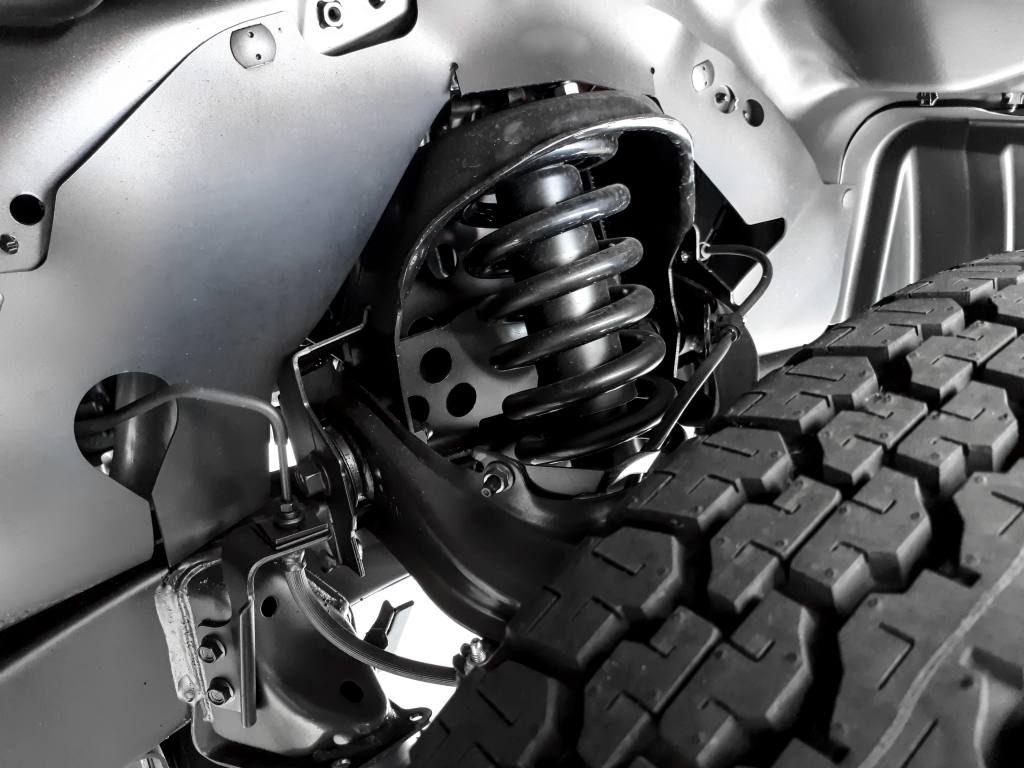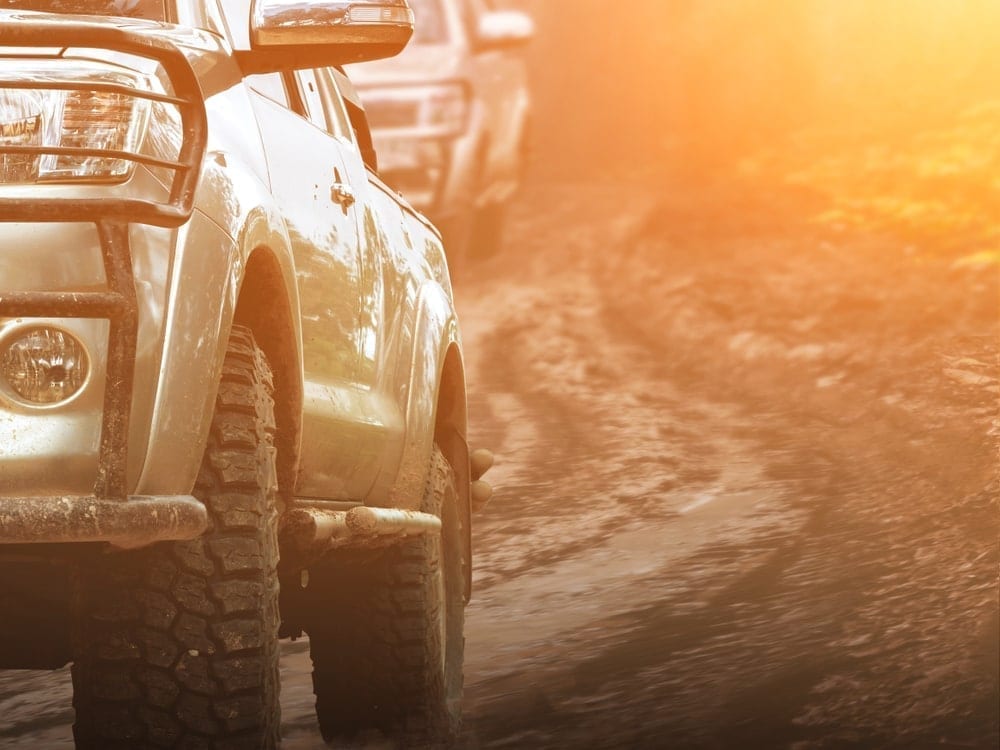Everything you need to know about the different types of 4×4 suspension systems.
There will come a time when you are faced with the question, “what is the best 4×4 suspension system for my car?”. This may come a lot sooner if you’re already looking for ways to jack up your rig as high as possible. Because bigger is always better right?
Well, we hate to burst your bubble, but bigger isn’t always better when it comes to 4×4 suspension systems. In fact, it’s probably going to be a really rough ride if you end up listening to your mate who’s lifted their Hilux 50mm above the legal limit.
When it comes to choosing the right 4×4 suspension system for your rig it all boils down to how well it meets demands of your lifestyle.
If you spend the entire weekend smashing through some of WA’s iconic off-road tracks such as Mundaring Powerlines.
Or, prefer throwing a line out and kicking back on the beach watching the sunset, we’ll go through the different types of 4×4 suspension systems.
So before you go out and drop your next paycheck on the biggest, worst suspension system, here’s everything you need to know.
How does 4×4 suspension work?

Similar to an on-road car, 4×4 suspension is an essential part which contributes to how well your 4WD handles, how capable it is on and off the road, and how comfortable the drive is.
4×4 suspension has been designed to greatly increase handling while driving off-road by absorbing impact while dampening vibrations felt inside after hitting a bump or driving across a rough surface.
It also helps with stability by making sure all wheels stay in contact with the ground and reducing the chances of rolling.
A good suspension system will increase your tyres contact with whatever surface you’re driving on, while increasing load-carrying capability and handling for a smoother ride.
What are the main components that make up 4WD suspension?
What are the types of springs?
The most crucial component of a 4WD suspension system is the springs. The springs are what supports the weight of your vehicle and controls the motion applied to the wheels below as you travel over uneven terrain. There are also 4 types of spring options, all with different characteristics for different applications.
- Leaf springs are ideal for carrying heavy loads. They are made of multiple pieces of spring steel — just like a leaf — are bolted to the axle.
- Coil springs improve handling and ride quality. With the right support, coil springs can also significantly improve carrying load and are ideal for travelling off road and over long distances.
- Torsion bars dramatically increase performance on and off the road. They take up less space than coil springs and improve ride quality and handling.
What does a shock absorber do?
Let me guess, your first thought was that shock absorbers absorb the impact of bumps. In reality, they don’t. However, they do reduce the movement of the spring, which ultimately absorbs the shock.
For example, if you’re off-roading in your 4WD and encounter a large bump bump, you will notice the movement of the car go up and down — but only once.
This is because the ‘shock’ movement in the spring has been absorbed, giving you a more comfortable ride.
What are the different types of 4×4 suspension?
Solid axle suspension
These suspension systems are located on both sides of a differential and are connected together with a single axle housing, this makes it dependent. When one wheel is moving up or down, it will directly impact the wheel on the other side.
Solid axles, also known as live-axle suspension, are more durable than most independent front suspension systems and increase traction to get over big bumps or hills.
They also provide more power from the differentials as there are fewer parts.
Advantages of solid axle suspension
- Can improve ride quality (smoother)
- Improve traction over big bumps and hills
- Gain more torque from the differentials
- More durable than most IFS axles
- Can be easily changed in comparison to IFS, making it easier to repair
Disadvantages of solid axle suspension
- May experience a more bumpy ride
- Less ground clearance due to axle design
- Heavier than independent front suspension systems
Independent suspension (IFS)
Unlike a dependent suspension system where two sides are connected by a single axle, the main feature of this system is that the suspension is not joined together.
At the centre of this system is an axle housing which contains the ring gear and carrier live.
Rather than axle tubes running out to each wheel, constant velocity axles are used. When one wheel moves up or down, it does not affect the wheel on the other side.
This allows drivers to easily maneuver difficult tracks, offering improved handling and front end clearance and greater.
Advantages of independent suspension
- A more comfortable ride
- Lighter in weight
- Improved handling
- May improve front end clearance
Disadvantages of independent suspension
- Can be more expensive
- More complicated setup
- Repairs are more complex (and costly)
- With more joints comes more maintenance; lubrication
- Susceptible to wear and tear, and damage
- Less durable
The 5 most important factors to consider when choosing a 4×4 suspension system
1. Weight capacity
Think about everything you load up onto your fourbie when going on an adventure, now think about all the modifications you’ve just slapped on.
From bull bars and rear bars, to dual fuel tanks, fridges, roof racks and more, all this added weight decreases the overall performance and safety of your vehicle.
2. 4WD flex
Once you’ve calculated your total weight capacity, the next thing to consider is 4WD flex. The best way to think about it is are you someone who enjoys the occasional bush bash Vs someone who isn’t afraid of tackling Mundaring Powerlines hardest track?
The amount of flex will determine how planted your tyres are to the ground (traction), as well as influencing vehicle tilt.
The more flex you have the easier it will be to drive through deep ruts and decrease the chances of rolling.
3. Comfort
If you spend most of your time travelling to remote areas with the occasional off-roading or finding the best beach fishing spot, you’ll definitely want to select a suspension system that improves comfort.
There’s nothing worse than spending 6 hours in the car and feeling every single bump.
4. Durability
Durability comes down to the terrain you drive on and the activities you frequently do. If you spend most of your time shredding some of WA’s most rigorous off-road tracks or travel long distances then you’ll want heavy duty shock absorbers.
5. Terrain
Terrain plays a major role in determining the type of suspension you choose. If you only plan on using your fourbie for urban driving then you probably won’t need that $4,000 suspension system you’ve been contemplating for the last month or so.
However, if you plan on pushing the limits of your vehicle through some of the roughest of tracks, then we recommend going for a heavy-duty suspension kit that suits your needs.
How long does 4×4 suspension last?
It all depends on the driving you’re doing. If you’re a weekend warrior tackling some of Perth’s craziest off-road tracks every weekend or travel to remote areas on long family road trips, your suspension will wear out much faster.
That being said, you should always have your suspension checked regularly, particularly if frequent off-road tracks.
How do lift kits work?
4×4 lift kits lift your suspension and help you get the height you need to tackle muddy rutted trails, beach tracks and water crossings, through to constructions.
Various types of lift kits can provide anywhere from 2 inches all the way to 5 inches of lift. That’s heights of 40mm, 80mm, 100mm and 125mm.
Note: The height at which you can lift your vehicle varies from state to state, and is usually linked together with the size of your tyres.
The legal road height you can lift your vehicle in Western Australia is 50mm from larger tyres and a 25mm suspension lift without any form of engineering.
More info on suspension and lift kits
We have a library of resources you can access on suspension.
- A Guide on How to Check Your Car’s Suspension
- WA Regulations on Common 4WD Accessories
- What Are 4×4 Lift Kits and Do I Need One?
Elevate your off-roading experience to all new heights with Total 4×4
The great Australian outback can be a harsh and unforgiving environment. Without the right 4WD suspension, you’re going to find it almost impossible to tackle some of the best off-road tracks WA has to offer.
When it comes to tailoring a lift kit best suited to our clients’ needs, we take into account whether or not the vehicle has been fitted with a bull bar, the rear load requirements — be it light, medium or heavy.
Rear load rating can vary dramatically, depending on what luggage, material or recovery gear is intended to be carried in the cargo area.
If you’ve got a drawer system, long-range fuel tank, twin wheel carrier or even a steel rear step type bumper is fitted, we ensure you receive a kit that suits your needs while adhering to WA standards and regulations.
If you’re in doubt, contact the professionals at Total 4×4, we more than are happy to inspect your 4WD, provide expert advice and supply/install high quality 4×4 accessories.
